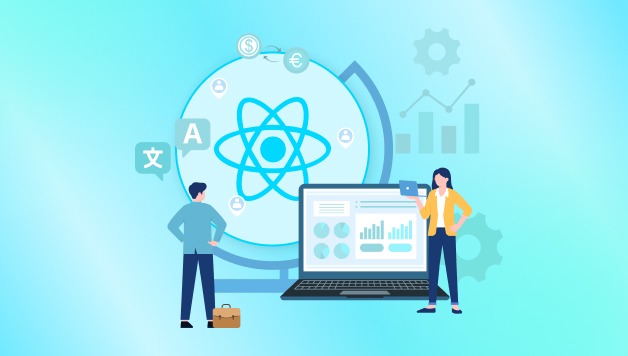Expanding your SaaS product into international markets is a major milestone. But before you think about marketing, localization, or customer support, one crucial technical priority must come first — internationalization in React. For any global SaaS launch React strategy, i18n should be baked into the product from day one.
Building an application that’s globally scalable goes beyond translation. It requires structure, foresight, and the right tooling to make multilingual expansion seamless. In this article, we’ll cover why i18n in React is a foundational step in global SaaS deployment and how it fits into a smart go-to-market strategy.
What is i18n and Why Does It Matter in SaaS?
Internationalization (i18n) is the process of designing and structuring your application to support multiple languages, regional settings, currencies, and formatting. When implemented correctly in React, it allows developers to easily plug in localized content without rewriting the core application logic.
When planning a global SaaS launch React, skipping i18n in the initial build results in major rework, delays, and added costs during expansion. That’s why top SaaS companies now prioritize react js internationalization from MVP stage itself.
Why i18n in React Should Be Phase One of Your Global Launch
Whether you’re entering a multilingual region or targeting enterprise clients abroad, here’s why your team should prioritize i18n first.
🌐 1. Accelerates Time to Market Globally
With a flexible i18n setup, adding new languages becomes a content task, not a dev task. This lets you roll out updates and new regional offerings quickly.
🛠️ 2. Reduces Technical Debt
Retrofitting multilingual support later leads to code duplication and refactoring headaches. A solid internationalization setup from the start eliminates this risk.
🌍 3. Builds User Trust Across Cultures
Localized apps feel more natural and respectful to users, especially when region-specific formats, currencies, and layouts are handled properly.
🔍 4. Improves International SEO
Search engines favor content that is localized and optimized for the user’s language. i18n enables you to structure your site properly with hreflang tags and locale-based URLs.
💼 5. Attracts Enterprise & Government Clients
Many global enterprises and government agencies only consider vendors that support their native languages. Without i18n, you may lose out on major opportunities.
Tools to Support i18n in a Global SaaS Launch React Strategy
For SaaS teams using React, several libraries simplify i18n implementation:
- react-i18next – Most popular for React apps; supports dynamic loading, fallback languages, and context-based translations.
- LinguiJS – Lightweight and performance-focused, ideal for modular SaaS architectures.
- React Intl (FormatJS) – Advanced formatting features for dates, numbers, and pluralization across regions.
These tools are frequently adopted by expert reactjs development services to streamline multilingual app development and ensure scalability.
i18n Planning Tips for Multilingual SaaS Applications
Here are some practical tips to align your architecture with best practices for multilingual SaaS applications:
✅ Design Language-Aware Components
Wrap text using translation functions from day one. Avoid hardcoded strings, even during prototyping.
✅ Modularize Translation Files
Split your translation JSON files by feature or screen, which keeps things manageable as your app scales.
✅ Detect & Persist User Locale
Use browser preferences or user profiles to detect preferred language and remember it with cookies or localStorage.
✅ Plan for Right-to-Left (RTL) Support
Even if you’re not launching in RTL regions initially, build your layout in a way that can adapt easily if needed.
✅ Use External Translation Services
Tools like Phrase, Lokalise, or Crowdin make it easier for marketing and product teams to manage content without developer intervention.
How ReactJS Development Services Help with Global Launches
Launching a SaaS product globally requires more than just technical execution. Skilled reactjs development services bring experience, speed, and frameworks that reduce friction during i18n implementation.
These partners often provide:
- Pre-built i18n integrations
- Localization-friendly UI design
- SSR support with frameworks like Next.js
- Automated testing for different language variants
- Integration with translation management tools
By working with experts, you can reduce risk, save time, and go to market with a polished, localized product.
Conclusion
If you’re preparing for a global SaaS launch React strategy, internationalization must be part of your phase-one planning. The cost of delaying i18n is high — both technically and in lost market opportunities.
By implementing internationalization in React from the beginning, your team can:
- Expand faster into multilingual markets
- Deliver better user experiences
- Improve SEO and accessibility
- Reduce the cost of future rework
Don’t wait until you’re ready to launch in another language. Build with i18n today — because your future users are already global.
- Why i18n in React Matters for Global SaaS Launches
- Planning a global SaaS launch? Learn why i18n in React should be your first step. Explore tools, strategies, and multilingual implementation tips.
- react js internationalization, multilingual SaaS applications, global SaaS launch react
Related posts:
 High-Quality Biomedical Waste Incinerators & Laboratory Glassware Made in India
High-Quality Biomedical Waste Incinerators & Laboratory Glassware Made in India
 Understanding the Role of IoT in Modern Manufacturing: A Comprehensive Guide to Smart Factories and Industrial Transformation
Understanding the Role of IoT in Modern Manufacturing: A Comprehensive Guide to Smart Factories and Industrial Transformation
 Smarter Business Networks Start with a Cisco Solution Provider Partner
Smarter Business Networks Start with a Cisco Solution Provider Partner
 Best Account Management Software for All Businesses – EmizenTech
Best Account Management Software for All Businesses – EmizenTech
 Top 15 Global Website Design Companies You Can Hire in the 2025
Top 15 Global Website Design Companies You Can Hire in the 2025
 Empowering Qatari Retail Businesses with Microsoft Dynamics 365 Commerce
Empowering Qatari Retail Businesses with Microsoft Dynamics 365 Commerce
 Safety Procedures in Heavy Equipment Moving: Best Practices for Workplace Security
Safety Procedures in Heavy Equipment Moving: Best Practices for Workplace Security
 How Microinteractions Are Revolutionizing Mobile UI/UX Design in 2025
How Microinteractions Are Revolutionizing Mobile UI/UX Design in 2025








